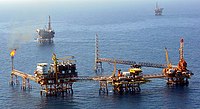
Photo from wikipedia
Abstract Liquefaction potential analysis is a required task in the foundation design process of offshore wind turbine in Taiwan. The standard penetration test (SPT) is mostly used in the preliminary… Click to show full abstract
Abstract Liquefaction potential analysis is a required task in the foundation design process of offshore wind turbine in Taiwan. The standard penetration test (SPT) is mostly used in the preliminary soil investigation of the pilot offshore wind farm in Chang-Bin, Taiwan. Due to the different experimental conditions and operating conditions, the N value (SPT-N) of SPT varies greatly. This study applies statistical methods in conjunction with the New Japan Road Association simplified-empirical method (NJRA method) to incorporate the uncertainty of SPT-N values into the offshore liquefaction potential assessment to quantify the risk of seabed liquefaction. The study statistics the field experimental geotechnical parameters SPT-N and determines the probability density function of the SPT-N distribution of each layer of soil in the offshore wind farm. In order to quantify the risk of seabed soil liquefaction potential, the Monte Carlo random sampling method is used, and by the NJRA method to carry out the seabed liquefaction potential in Changhua, Taiwan. After comparing, the results obtained by the current SPT-based soil liquefaction potential assessment by deterministic approach are conservative. In the ground investigation of offshore wind farm development, the method proposed in this paper can access the thickness of liquefiable soil layers under any given probability for optimizing offshore wind turbine foundation design.
Journal Title: Engineering Geology
Year Published: 2020
Link to full text (if available)
Share on Social Media: Sign Up to like & get
recommendations!